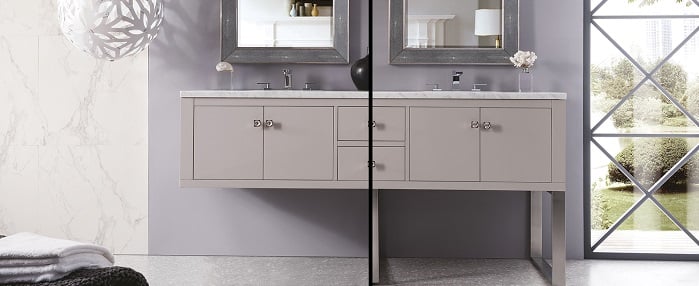Wall mounted bathroom vanities are becoming increasingly popular. But you might be surprised to learn that many include legs that can be attached or removed before the vanity is installed. You won’t see this much in traditional design, and it might seem a little strange. After all, why would vanities have legs if they aren’t needed? But simply providing the option whether to install the legs or not makes for an interesting choice between two very distinctive styles, each with their own unique advantages and drawbacks.
Why Add Legs To A Wall Mounted Vanity?
The most obvious benefit of wall mounted bathroom vanities is that they’re visually striking. Without the legs, the stark, simple lines of a modern bathroom vanity gain a gorgeous, gravity defying appearance. This can add a uniquely modern sense of elegance to a bathroom. Adding legs back onto the vanity ruins this effect entirely; it will break the illusion that the vanity is floating and give it a much more ordinary, less daring look.
Aesthetics vs Ease Of Installation

On the flip side, the greatest advantage of adding those legs back on is equally simple. You don’t have to mount the vanity to the wall. Wall mounting a bathroom vanity can be difficult and complicated for a number of reasons. Everything from stud placement to the weight of the vanity can make wall mounting more trouble than it’s worth. A vanity with good, sturdy legs negates all those concerns. You simply set it in place like you would any other piece of furniture, no complicated installation needed.
Shop Wall Mount Bathroom Vanities:
Slim, Open-Shelf Storage
The legs themselves can also be visually interesting in their own regard. While many models come with simple square or cylindrical metal legs, others use the space to get a little creative. Interestingly shaped or unusually placed legs are also common (I’ve even seen vanities mounted on a single post!). More complex frame-like legs can add storage to a wall mounted vanity, while still keeping that sleek, open-air feel.
Adjustable Vanity Legs To Match A Vessel Sink
On some vanities, legs that are removable or height-adjustable are a more practical consideration. A vessel sink can alter the overall height of your vanity, leaving your sink a little too far up and uncomfortable to use. With traditional built-in vanity legs, there’s no way to fix the problem. Opting for adjustable legs will give you a little more wiggle room. Rather than simple levels (which is pretty standard on most vanity legs), these let you alter the height of the vanity by as much as six inches, to match the height of your sink.
Wall Mount Without Legs For Peak Customizability
Wall mounted bathroom vanities are even more versatile in this regard, since you can install them at any height. That makes it possible not only to accommodate a taller sink, but also to custom match the height of the vanity to the height of the people that will primarily be using it, whether they’re particularly tall or particularly small. While the installation is obviously more complicated (and permanent), the results are also more precise and personalized. Plus, you won’t need to check and double check the manufacturer’s listing to make sure you’re getting legs that are or adjust to exactly the height you need.
Legs Or Not, You’re Still Getting The Same Vanity
All that said, even when sold under different names or item listings, bathroom vanities with legs that can be added or removed interchangeably are really the exact same bathroom vanity. That means that – appearance and installation notwithstanding – there isn’t any difference between one item and the next but what you choose to do with it. One of the main complaints about wall mounted bathroom vanities is that they sacrifice storage space for aesthetically pleasing (but less useful) white space. But unless you choose a set of “legs” that turn your wall mounted vanity into an open-shelf vanity, simply adding on legs won’t fix this problem.
Ultimately, the choice is a practical one only at the time of installation. From there, it’s purely aesthetic!






